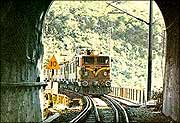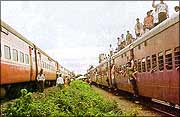The Rediff Special/ George Iype


India has the second largest rail network in the world, transporting over four billion people annually.
India also has 120,000-plus steel bridges, a lot of which are ageing, weak, distressed, accident-prone.
Everyone knows this -- those who run the railways, and those who travel by it. The difference is that the former won't do anything about it, and the latter can't.
Fifty-two people have died, when three coaches of the Mangalore-Madras Mail tumbled into the Kadalundi River, near Kozhikode in Kerala, last Friday. The collapse of one more ailing, ageing bridge was the cause.
Will the tragedy spark concern over the state of our rail bridges? Will the railways ministry swing into high gear to prevent such tragedies in the future?
Unlikely. Since 1986, there has been between 200 to 250 accidents, major and minor, across the railways network every year. In that time, 6,000-plus people have died, and many times that number have been injured in rail accidents.
The official line never varies: Accidents, it is said, will be inevitable across such a vast network. And every accident till date has been followed up by the inevitable inquiry, and the as-inevitable conclusion: "Human error."
 Experts argue that this is an example of the officials taking the easy way out. If 'human error' is shown as the cause of the latest tragedy, a suspension of the person deemed at fault ends the story. If, however, the failure of the system -- tracks, bridges, signalling systems, whatever -- is deemed to be the cause, then it implies a lot of remedial work for the ministry and the officials, and this is what is sought to be avoided.
Experts argue that this is an example of the officials taking the easy way out. If 'human error' is shown as the cause of the latest tragedy, a suspension of the person deemed at fault ends the story. If, however, the failure of the system -- tracks, bridges, signalling systems, whatever -- is deemed to be the cause, then it implies a lot of remedial work for the ministry and the officials, and this is what is sought to be avoided.
"Human error is only a small part of the story," says K J Diwakar, a retired safety officer in the Indian Railways. "It is the huge number of old bridges over rivers, canals and roads across the country that are the real tragic spots. "But no railway budget has, till date, made provisions for replacing these weak bridges. It is this disregard for the safety of the people that has caused the Kadalundi tragedy."
Of the estimated 120,000 bridges spanning the railways network, over half were built during the British Raj. And some of them, like the one spanning the Kadalundi River, are over 100 years old.
None of this is post-facto wisdom. As early as 1989, the Bridges Rehabilitation Committee had warned that the Kadalundi rail bridge had become a death trap and needed to be abandoned. It further ordered that, while the replacement bridge was being constructed, trains using the existing bridge should not run at more than 20 kmph.
The warning was ignored.
In 1999, the Railway Safety Review Committee, headed by Justice H R Khanna, produced a detailed report on rail safety measures. That report identified nearly 300 bridges as "weak and distressed" and in urgent need of replacement.
No action was taken.
But then, the official viewpoint is radically different.
 "We regularly repair and maintain the rail bridges, especially the old ones," says Railway Safety Commissioner Pranab Kumar Sen, adding that the department's first priority has always been the safety of the network and of those who use it. "Therefore, it is not right to say that the tragedy at Kadalundi happened because of neglect.
"We regularly repair and maintain the rail bridges, especially the old ones," says Railway Safety Commissioner Pranab Kumar Sen, adding that the department's first priority has always been the safety of the network and of those who use it. "Therefore, it is not right to say that the tragedy at Kadalundi happened because of neglect.
"Rail bridges are frequently inspected," Sen adds. "So it is unfair to claim that rail bridges across the country are not safe."
Meanwhile, they are still working to salvage the bogies that fell into the Kadalundi following the collapse of the bridge.
"In India, train tragedies have been on the increase because technological upgradation of bridges, and the construction of new ones, has been almost non-existent," says Rajamani Singh, who has served as overseer for a fair number of railways projects. "Every year, ministers introduce new routes, to meet the populist demands. But there is never any attempt to improve the network. Ultimately, it is the passengers who suffer."
Facts would seem to back up Singh's argument.
For instance, in 1995, the Purushottam Express and Kalindi Express crashed head on, thanks to a failure of the signalling system. Four hundred-plus people lost their lives in the country's worst-ever rail mishap.
Subsequent to the inquiry, the railways ministry earmarked Rs 2 billion for new signalling and telecommunications equipment. The upgradation project, however, died stillborn, and the money was never utilised.
Does that paint a picture of apathy?
Two years ago, it was estimated that 6,000 kilometres of railway tracks were in "bad shape" and in urgent need of replacement. The estimate came from the railways ministry. Till date, no remedial action has been initiated.
Experts have suggested that a system similar to the one being followed in the United States should be introduced in India. In that country, a National Transportation Safety Board looks after the safety aspects of its railway network and takes responsibility for all repairs, maintenance and upgradation. India, it is argued, needs a similar set-up to ensure that its high-traffic corridors are rendered less accident-prone.
 At present, India does not have such a body. It does, however, have a commissioner of railway safety. One of the jobs of this official is to carry out the mandatory inquiry that follows each accident.
At present, India does not have such a body. It does, however, have a commissioner of railway safety. One of the jobs of this official is to carry out the mandatory inquiry that follows each accident.
In 1989, the Bangalore-Trivandrum Island Express plunged into the Quilon River, killing 107 people. The commissioner of railway safety conducted an inquiry.
'A freak typhoon struck just as the train was crossing the bridge,' was the verdict.
The commissioner of railway safety is now inquiring into the Kadalundi disaster....
Page design: Dominic Xavier
You might also want to read...
The Kerala train mishap: The complete coverage
Bloody track record for Railways
Human error remains bane of Indian railways
The Rediff Specials